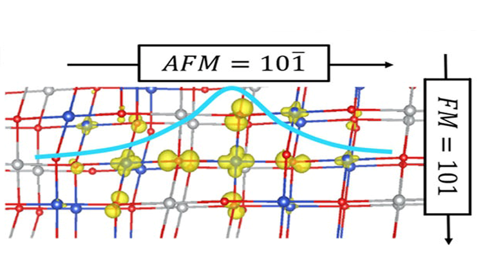 Mechanistic insights of enhanced spin polaron conduction in CuO through atomic doping (原子掺杂增强CuO自旋极化子传导的机制)
Mechanistic insights of enhanced spin polaron conduction in CuO through atomic doping (原子掺杂增强CuO自旋极化子传导的机制)
Tyler J. Smart, Allison C. Cardiel, Feng Wu, Kyoung-Shin Choi & Yuan Ping
npj Computational Materials 4:61 (2018)
doi:s41524-018-0118-3
Published online:19 November 2018
Abstract| Full Text | PDF OPEN
摘要:“自旋极化子”的形成源于磁性氧化物中强烈的自旋-电荷-晶格相互作用,这导致载流子的局域化,并伴随着局域磁化和晶格畸变。以氧化铜(CuO)为例,其为一种有前景的光阴极材料,且与高温超导体有多种相似的重要性质。CuO中自旋极化子在铜原子上形成,通过其跳跃传导来传输空穴,并伴随铜原子上的自旋翻转。自旋极化子的形成导致跳跃需要克服的激活能不仅与强电-声耦合相关,而且还与强磁耦合相关。总的来说,这些效应导致了CuO中低载流子传导,阻碍其实际应用。为克服这一重要瓶颈,我们基于第一原理计算揭示了掺杂同时改善磁性氧化物(如CuO)中空穴浓度和跳跃迁移率的机制。具体地,我们以Li掺杂为例,发现Li具有低的缺陷电离能,因而可提高空穴浓度,同时通过降低电-声和磁耦合相关的势垒,改善了跳跃迁移率。最后,通过合成Li掺杂的CuO电极,从实验上验证了理论预测的增强载流子传导,即在掺杂的电极中获得了相比未掺杂电极更强的光电流。我们认为,利用非磁性浅能级掺杂是改善磁性氧化物电导率的有效途径。
Abstract:The formation of a “spin polaron” stems from strong spin-charge-lattice interactions in magnetic oxides, which leads to a localization of carriers accompanied by local magnetic polarization and lattice distortion. For example, cupric oxide (CuO), which is a promising photocathode material and shares important similarities with high Tc superconductors, conducts holes through spin polaron hopping with flipped spins at Cu atoms where a spin polaron has formed. The formation of these spin polarons results in an activated hopping conduction process where the carriers must not only overcome strong electron?phonon coupling but also strong magnetic coupling. Collectively, these effects cause low carrier conduction in CuO and hinder its applications. To overcome this fundamental limitation, we demonstrate from first-principles calculations how doping can improve hopping conduction through simultaneous improvement of hole concentration and hopping mobility in magnetic oxides such as CuO. Specifically, using Li doping as an example, we show that Li has a low ionization energy that improves hole concentration, and lowers the hopping barrier through both the electron?phonon and magnetic couplings' reduction that improves hopping mobility. Finally, this improved conduction predicted by theory is validated through the synthesis of Li-doped CuO electrodes which show enhanced photocurrent compared to pristine CuO electrodes. We conclude that doping with nonmagnetic shallow impurities is an effective strategy to improve hopping conductivities in magnetic oxides.
Editorial Summary
Cathode materials: Cupric oxide invigorated (阴极材料:氧化铜焕发生机)
第一性原理计算揭示了利用掺杂提升氧化铜(CuO)电导率的机制。自旋极化子,即晶格畸变与自旋耦合共同激发的准粒子,其形成不利于载流子的传输,阻碍CuO作为阴极材料在光电化学电池或气体传感器方面的应用。来自加州大学圣克鲁兹分校和威斯康星大学麦迪逊分校的Yuan Ping教授等,分析了用锂掺杂来提升CuO电导率的可能性。他们的计算表明,锂掺杂同时降低了电-声及磁耦合导致的载流子跳跃势垒,同时提高了载流子浓度。他们进一步制备了锂掺杂CuO电极,与未掺杂CuO电极相比,其光电流得到了增强。
Calculations reveal the mechanism through which doping increases the electronic conductivity of cupric oxide (CuO). Spin polarons—quasiparticles where lattice distortions couple to spin excitations—have an adverse effect on the electronic transport in CuO, which is a problem for applying this material as the cathode in photoelectrochemical cells or gas sensors. Researchers from the University of California, Santa Cruz and the University of Wisconsin, Madison led by Yuan Ping have analyzed the process through which doping CuO with lithium alleviates this problem. Their calculations reveal that the Li dopants lower the hopping barrier for polaron-mediated transport through reducing both the electron-phonon and magnetic couplings, and the low ionization energy of the Li dopants improves hole concentrations. They also fabricate Li?CuO electrodes and demonstrate that these allow enhanced photocurrent compared to devices made from pristine CuO. This suggests a general strategy for enhancing the conductivity of magnetic oxides.


 沪公网安备 31010502006565号
沪公网安备 31010502006565号